Top Stories
Enough With the Phoney 'Lockdown' Debate
It’s been fuelled, on both sides, by the presumption that government decrees work as a sort of magic wand that will bring our economies (and perhaps the most acute phase of the pandemic) back to life.
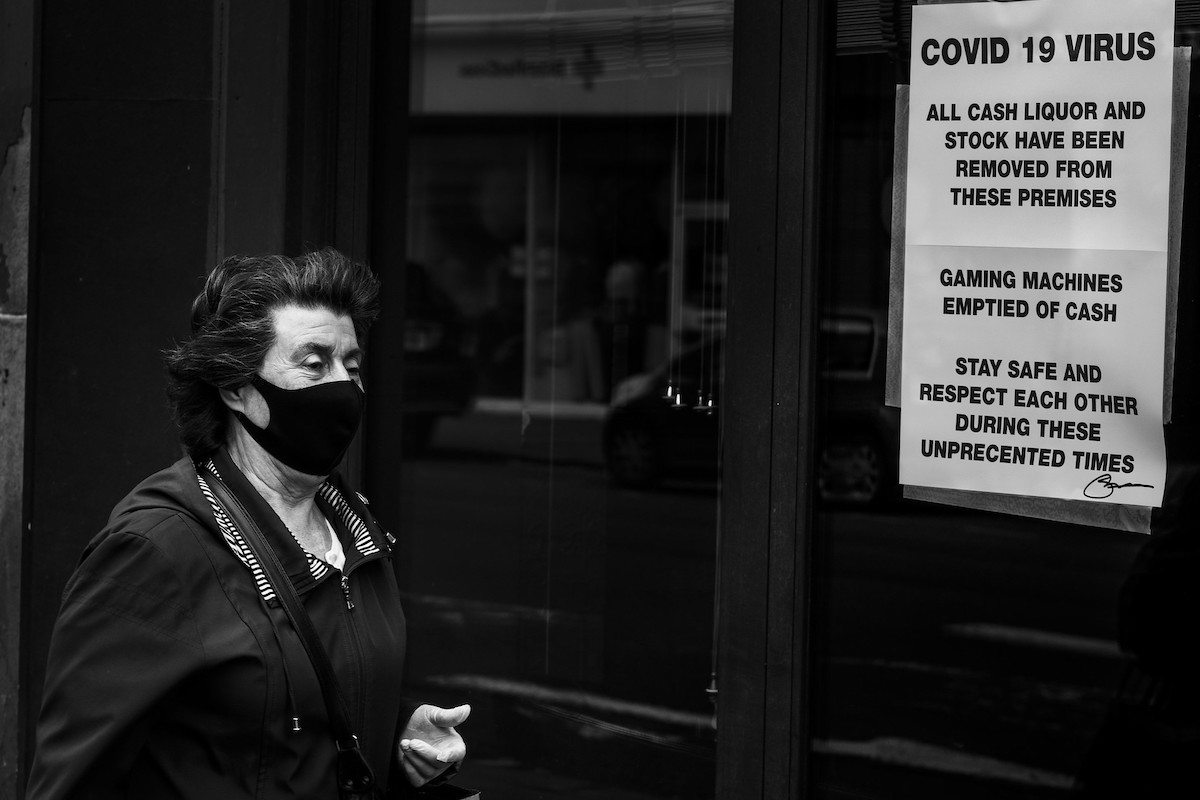
On March 15th, Washington state Governor Jay Inslee ordered all bars, restaurants and recreational facilities closed. The next day, New York followed suit, in a move coordinated with New Jersey and Connecticut. In Florida, by contrast, Gov. Ron DeSantis didn’t issue a stay-at-home order until April 1st, more than two weeks later. And in Sweden, there was never any real lockdown, even if bars and restaurants there have been operating under restrictions that govern use and occupancy.
Four jurisdictions. Four different lockdown timetables. Imagine if we were able to plot an index of human activity in these four places. These graphs would show, one might predict, that things were going along fairly normally, perhaps starting to dip, until a lockdown went into effect, and then activity levels plunged abruptly.
It so happens we can plot such an index, because Moovit, an Israeli-based transit-app service provider, has released its metadata in regard to ridership in dozens of cities around the world. And in the graph below, which I created based on Moovit’s numbers, you can see ridership (expressed in percentage terms, as a deviation from original baseline) versus time for four municipal groupings, corresponding to the above-listed jurisdictions: Seattle, New York City, Miami, and Stockholm. Without a legend to tell you which line matches with which city, can you tell which is which?
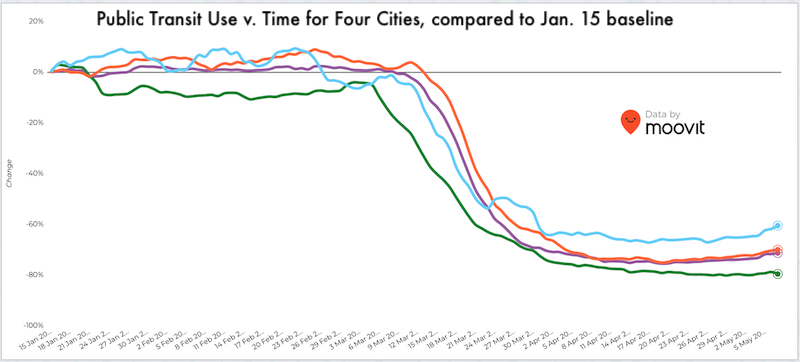
Seattle is shown in green. Its residents began staying at home on March 6th—more than a week before the state governor issued his order. While one might expect New York City to track closely with Seattle, given that the applicable state orders in New York and Washington were just 24 hours apart, the plunge in New York City/New Jersey ridership (Moovit lumps the two together), shown in purple, lags Seattle by a week.
In fact, the NYC/NJ data tracks very closely with that of Miami, shown in red, despite Florida’s (widely criticized) lockdown lag. Meanwhile, residents of two Swedish cities—Stockholm and the smaller Uppsala (grouped together by Moovit)—began staying at home slightly before New Yorkers, despite the fact that few were required by law to do so, either then or now. Here is another version of the same graph, but with the cities marked.

There’s a funny satirical article that’s been making the rounds titled Graph Lover Doesn’t Want This Sh*t To End. I will confess that it hits very close to home. And I realize that many readers may have already had it up to the gills with graphical depictions of COVID-19’s health and socioeconomic effects. But some of us are even more exasperated with the overheated politics surrounding the “lockdown debate”—the running, roiling argument about when and how governments should continue to lift the restrictions put in place during March and April.
I’ve spent a lot of time looking at this kind of data in recent weeks, and trying to tease out the policy ramifications. One of the trends that’s jumped out is that lockdown orders have tended to ratify public behaviour as much as prescribe or circumscribe it. Seattle residents essentially began imposing a lockdown on themselves before their government did, because the city had become one of the country’s leading early COVID-19 hotspots. Likewise, most Swedes didn’t need their government to tell them to stay home. Like everyone else, they get their news from the globalized data dump and anxiety mill known as social media. They all saw what was happening in Italy and elsewhere.
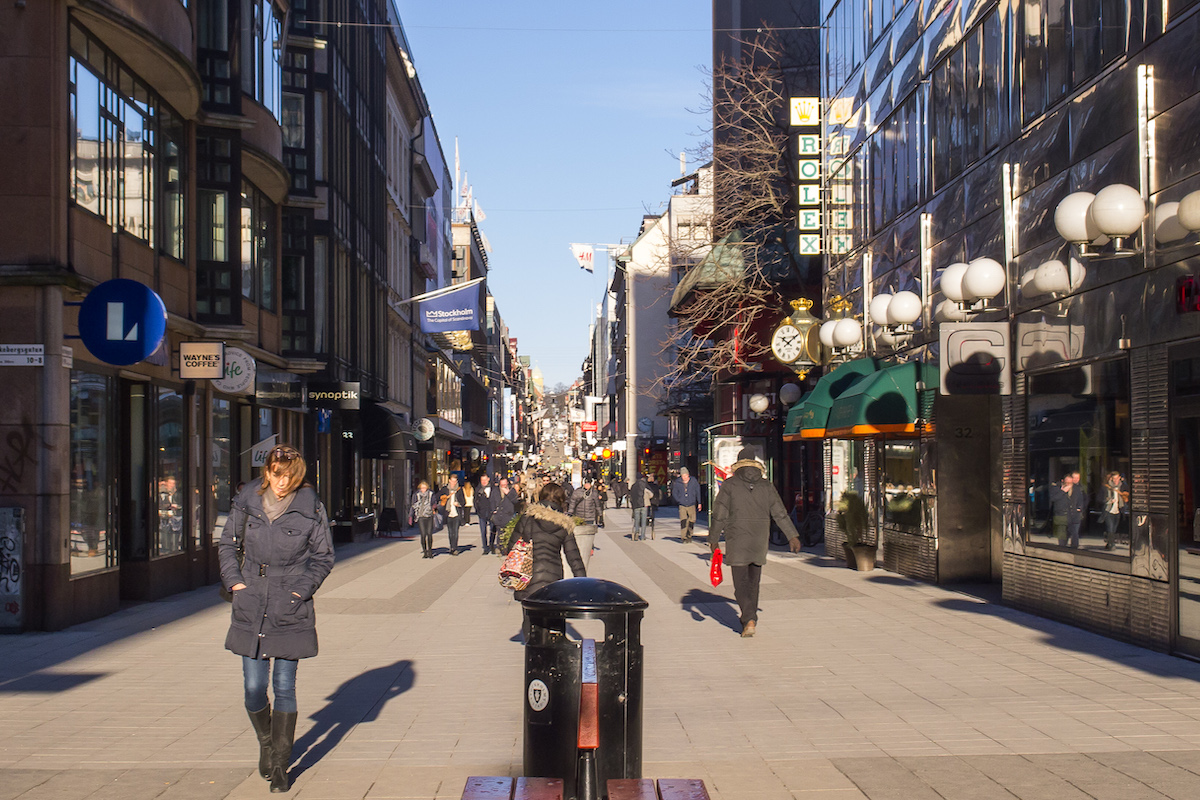
And this is why I find the lockdown debate so phoney. It’s been fuelled, on both sides, by the presumption that government decrees work as a sort of magic wand that will bring our economies (and perhaps the most acute phase of the pandemic) back to life. But the data suggest there is no magic wand. Much of the lockdown effect was imposed not by top-down fiat, but through millions of small decisions made every day by civic groups, employers, unions, trade associations, school boards and, most importantly, ordinary people.
Here in Toronto, where I live, for instance, I know relatively few people whose decision to work from home (or not work at all) was dictated by government order. Most white-collar employers told workers to stay at home days or weeks before official rules went into effect. And many service industries closed up shop because there simply weren’t any customers. Electricity-usage data reported by the New York Times, similarly, show that people became homebodies well before they were required to do so.
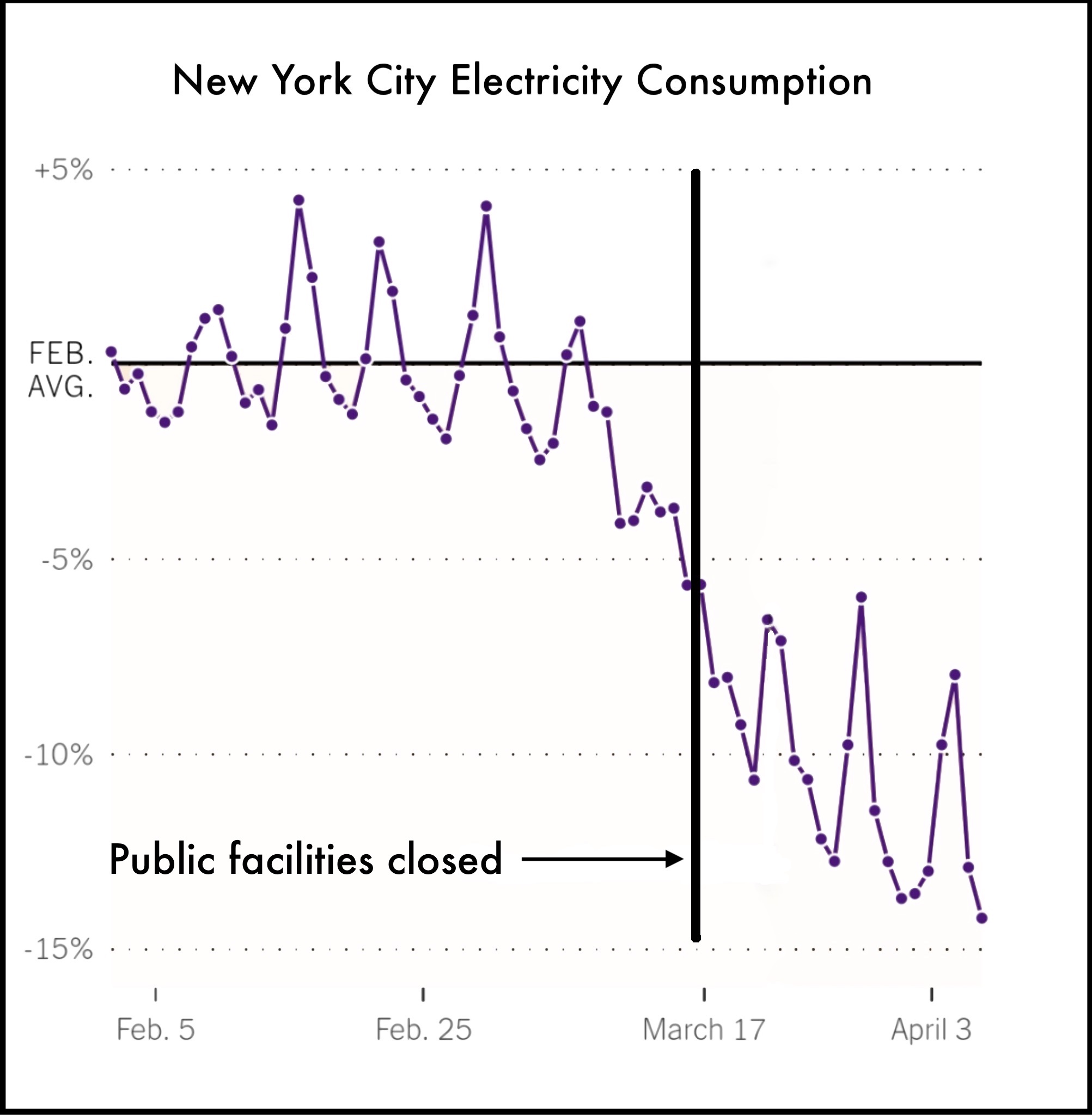
An understanding of the crowdsourced nature of the lockdown seems absent from a lot of the most detailed commentary that one sees on offer. Consider the website Lockdown Sceptics, featuring the work of my Quillette colleague Toby Young, which recently published a detailed critique of the influential COVID-19 epidemiological models produced by Neil Ferguson and his colleagues at Imperial College London.
As someone who once earned a pay-check writing similar (albeit more primitive) mathematical models back in the 1990s, I take a pedant’s interest in such intellectual excursions. (To wit: I would argue that the author’s central point of attack—the non-deterministic aspect of Ferguson’s model—is completely beside the point. All non-linear, iterative dynamical systems, such as are represented by this kind of epidemiological model, tend to generate output that’s massively sensitive to initial conditions and operating parameters. And so they are invariably non-deterministic to begin with. I also didn’t appreciate the author’s drive-by on FORTRAN, my old programming language. But I digress.) In truth, however, it was never necessary for this (or any) author to dive into the innards of Ferguson’s model to understand how divorced from reality it was. One merely had to read the original March 16th Imperial College report, which presumed to model various aspects of society’s functioning with a binary sawtooth function—100 percent or zero, and nothing in between—according to the imposed legal regime. Consider Figure 4 from that report, reproduced below, in which policy changes, which are triggered on and off according to intensive-care-unit usage, generate rolling waves of huge infection spikes.
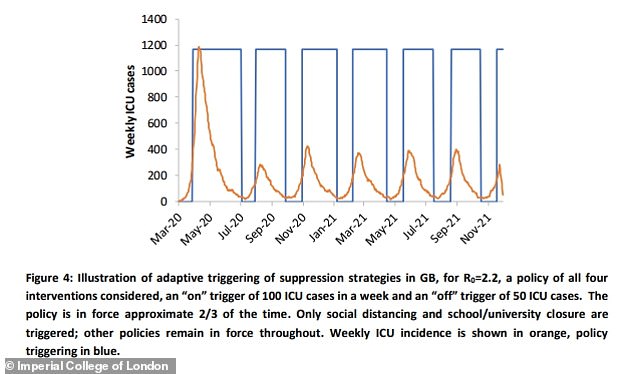
That kind of model would make complete sense in a universe where government had the power to dictate our behaviour completely, in the way that someone flicks a light switch. But as the transit data would suggest, it doesn’t. Even if every government on Earth lifted the lockdown tomorrow, those transit numbers probably wouldn’t pass the 50 percent threshold for months. Getting back to 100 percent may take years—if it ever happens at all.
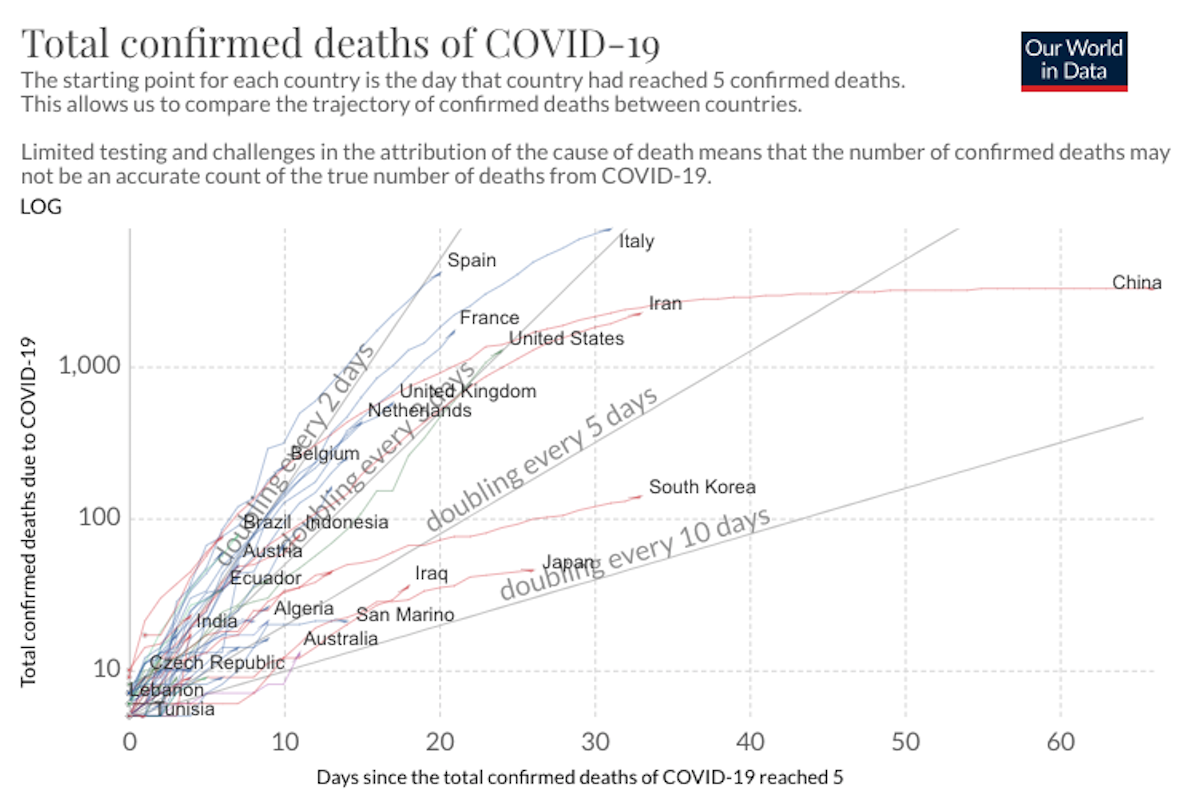
The skeptics who argue that lockdowns “don’t work” usually will support this claim by ticking off nations or regions that have succeeded in fighting off serious COVID-19 outbreaks without imposing harsh government restrictions. But when you parse the actual data, what you find is that these tend to be high-trust, high-education, high-information societies—such as in Scandinavia and East Asia—where official lockdowns haven’t been necessary precisely because a critical mass of people have effectively locked themselves down on their own. If spring-breakers in Miami were as conscientious and disciplined as, say, most office workers in Stockholm or Tokyo, the state’s governor wouldn’t have had to clear the beaches. But they’re not, so he did. Such spectacles tell us a lot about college students, but not much about lockdowns.
The crowdsourced aspect of lockdowns is bad news and good news. It’s bad news because getting all of society’s actors on the same page will take many months. And so, as state-level data already show, we won’t be able to get our economies up and running on anything like the speedy timeline that most self-styled lockdown opponents are seeking. But it’s also good news, because a slower, crowdsourced form of lockdown lifting will be subject to a whole slew of negative feedback mechanisms among ordinary people and employers, such that localized outbreaks naturally lead to corrections. And so we can avoid the problem, depicted in Ferguson’s graphs, by which sudden quantum shifts in centralized policy yield behavioural spikes whose catastrophic effects set off an endless wave of epidemiological boom and bust.
To repeat, the analytical mistakes being made here are not unique to lockdown proponents or “skeptics.” Both sides of the debate systematically overestimate the role of government, largely because arguing about what government should or shouldn’t be doing, while assuming this question to be the key to success or failure, has become the go-to reflex of pundits and even many public-health officials. But by indulging these reflexes, we expose our wilful blindness to both the surprisingly marginal role of government in many aspects of lockdown policy, and the semi-permanence of many mitigation strategies that already have been imposed by countless civic and economic actors. Indeed, while reading the broadsides that emit from both camps, I often think these people should all just get out more and see what is actually happening beyond their web browsers and spreadsheets.
My neighbourhood Greek bakery, for instance, is a place where every other customer seems to be 90 years old, where most of the business comes from loyal regulars, and where a good many transactions once were conducted amidst a flurry of warm hugs, handshakes, kisses, gossip, and complaints. (This is charming in theory, but annoying when you’re standing in line for Greek donuts.) The bakery stayed open these last two months because it is an “essential service.” But there are no more hugs and kisses and hair touslings and pinches of annoyed little girls’ cheeks. Counter-to-ceiling plastic shields have gone up to protect the cashiers. Dots on the floor tell us where to stand. You can’t use cash, just credit-card tap. Now— Opa!—please take your galaktoboureko and leave.
Little of this self-imposed “lockdown-lite” is going to change in coming weeks and months, regardless of what government does, even as the masks come off and the floor dots start to fade. The changes we’ve made are sociologically sticky and, in some cases, literally hard-bolted into our public architecture.
In fact, many of the most important mitigation strategies are unknown to the general public because they’ve taken place behind closed doors on the initiative of employers, not bureaucrats, and have little or nothing to do with legal mandates (which are themselves, as I can attest is the case here in Canada, a contradictory, hastily-conceived patchwork of federal and provincial directives and advisories). To give but one example I happen to be familiar with: Many of the men and women you see driving delivery trucks and construction vehicles are now governed by all sorts of rules, at pickup and drop-off, that allow them to perform their functions without coming within six feet of others. In some cases, they’ve been enabled with apps on their phones or dash-mounted tablets that permit them to coordinate these functions without any direct on-site human interaction whatsoever. Or they might be subject to thermometer-gun screenings to determine if they have a fever. Having implemented these lockdown-lite policies at great cost and inconvenience, employers aren’t going to dump them the moment the government gives them permission to do so, even though these procedures have increased costs and decreased output.
Many employers I speak to are actually far more constricted by the concerns of their own employees than by the law itself. At one workplace that I know of, the boss announced that loosened provincial restrictions mean that everyone can come back to work this month. To his surprise, his employees announced that they’d voted on the issue through Facebook, and, no, they would not be coming back, at least not yet. And in Quebec, which is starting to let elementary-school students come back to class this month, thousands of parents—a majority at some schools—have decided to keep their children home. I am told by reliable sources within my own family that some of these parents are even pressuring their neighbours to do likewise, and are shaming dissenters on social media as bad parents. It’s lockdown by mob.
To some extent, I find this attitude of populist hyper-vigilance to be exasperating, because sending your young kids to school is now generally safe (and, selfishly, because I think my own seven-year-old could benefit from getting back to a structured education environment). But we got into this mess by letting our guard down, and so it’s not surprising that many ordinary people want to err on the other side of the equation for a month or three. Whatever your views, though, if you’re all in a fuss about lockdown policy, please remember that the real lockdown was never imposed by government. It turns out that it was inside each and every one of us all along.






